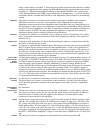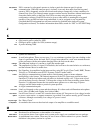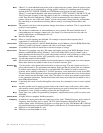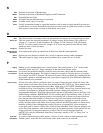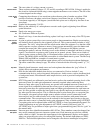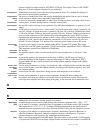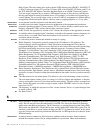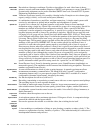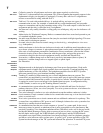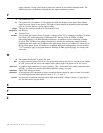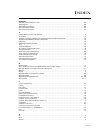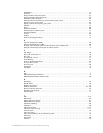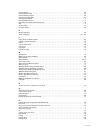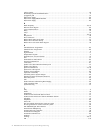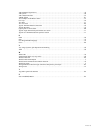148 Handbook of Intercom Systems Engineering
SMPTE/EBU
Time Code
Recorded on videotape or audiotape. Provides a time address for each video frame in hours,
minutes, seconds, and frame numbers. Requires a SMPTE code generator to create. Some RTS™
Systems audio equipment can be used to distribute SMPTE time code. Consult RTS™ Systems
Engineering Department for details.
Sound
Variations in pressure (usually air) caused by vibrating bodies. Examples are air columns (pipe
organs), strings (violins), vocal cords and larynxes (humans).
Sound System
A combination of transducers, amplifiers, and interconnections. A simple sound system could
consist of a microphone or pickup and an amplifier and a headphone or speaker.
Special List
A special list is a means for a keypanel operator to talk and/or listen to several unrelated
destinations using a single key. Special lists are useful for group call or zone paging. Special list
members are defined in the intercom configuration software. Once a special list has been
configured, it can be assigned to a keypanel key. A special list is a group of intercom ports that a
keypanel operator can talk or listen to by activating a single key. Special lists are typically used
for paging, all call, group call etc. Special lists have default names SL01, SL02 etc. These names
can be changed using Other Alpha setup. You define the members of the special list using Special
List setup. Once a special list has been set up, you typically assign it to a keypanel key using
Keypanel setup. The keypanel operator can then activate the special list key to talk or listen to all
members of the special list. IMPORTANT: Do not confuse special lists and Party-Lines. A
special list is used when a keypanel operator needs to occasionally talk or listen to a group of
intercom ports that are otherwise unrelated. A Party-Line is typically used when several users of
non-keypanel devices (such as belt packs or camera intercoms) are engaged in a specific common
activity and they need to talk and/or listen to each other all the time. Keypanels are almost never
members of Party-Lines (although they can be). However, a keypanel key can be assigned to
occasionally talk or listen to a Party-Line if desired. Just remember: Party-Lines are primarily set
up for Party-Line members, with occasional access by keypanel operators, while special lists are
set up exclusively for keypanel operators to talk or listen to several unrelated intercom ports. For
specific information about special list setup, search for “special list” in AZ™EDIT help.
SPL
Sound Pressure Level. Sound is alternating pressure waves. Sound Pressures (amplitudes) are
measured in pascals. The amplitudes can be converted into decibels using an equation. These new
numbers are Sound Pressure Levels.
Squawk (Versus
Matrix)
A term to differentiate two kinds of point-to-point intercom. A squawk type intercom allows
instantaneous momentary communication. The Model 810 in the “squawk” configuration
(momentary buttons only) is a pure squawk system. The Model 810 is available in a “matrix”
configuration (alternate action buttons, electrically the same).
Stacked Key
See the descriptions for talk level, talk level 2.
Stereo
Recording, transmitting or reproducing a sound source with two or more separate sound pickups.
The recording has two or more separate channels.
Studio Camera
Used both in studios and remote locations. A heavier, larger camera mounted on a pedestal or
other suitable mount. Generally has better quality pictures than a lighter, smaller field camera.
Studio Talkback
A loudspeaker system from the control room to the studio. Also called SA (Stage Announce, or
Studio Announce).
Supra Aural
Headset
A headset where the earpieces rest on the ear.
Supercardioid
A microphone pattern with a maximum rejection at 125 degrees off axis. A compromise design
between the cardioid and the hypercardioid.
Switcher
(usually the
Technical
Director)
Person who operates the switcher to switch the video; the switching device itself.
System
1. An assemblage or combination of things or parts forming a complex or unitary whole. 2. The
structure or organization of society, business, or politics. 3. The interrelationship of a collection of
interdependent elements and processes.



